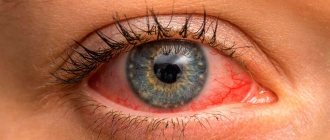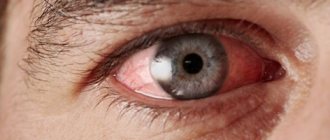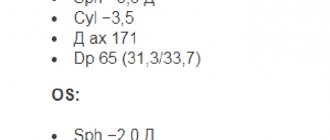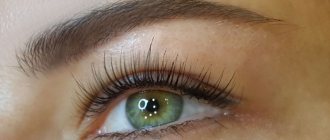Cyclomed is an eye drop that is used for the diagnosis and subsequent treatment of diseases of the organs of vision. This drug has an effect on the central nervous system; it should be taken only as prescribed by a doctor. In recent years, drug addicts have begun to actively use the drug; they drip Cyclomed into the nose. After this, side effects occur that are very similar to drug intoxication. It is worth knowing that instilling this medicine into the nose can be fatal.
Composition and effect of the drug
The drug Cyclomed contains cyclopentolate hydrochloride, an active ingredient that dilates the pupil. The medicine is released in the form of a 1% solution. This means that 1 ml of the drug contains 10 mg of the active ingredient. Drops contain excipients: water for injection, benzalkonium and sodium chloride, disodium edetate.
The action of the drug is aimed at dilating the pupil.
The effect of using the product appears after 15-20 minutes and lasts on average 7-12 hours.
Sometimes mydriatic phenomena persist throughout the day from the moment of instillation into the eyes.
Indications
The drug is prescribed for keratitis, iridocyclitis, uveitis and other inflammatory eye diseases. In children and adolescents, it is used for the diagnosis and treatment of false myopia (spasm of accommodation).
It is used in preoperative preparation for phacoemulsification - cataract surgery. Cyclomed dilates the pupil and facilitates access to the lens of the eye. Thanks to this, the surgeon can perform the operation without damaging the iris. Drops are also used for the diagnosis and treatment of ophthalmic diseases.
The drug affects the eye muscles that regulate the constriction and dilation of the pupils.
Indications for the use of Cyclomed:
- Preparation for ophthalmoscopy. Pupil dilation allows the doctor to clearly examine the fundus and see pathological changes in the retina, choroid, optic nerve, and retinal vessels.
- Definition of refraction - the refractive power of the eye. Cyclomed is dripped into the eyes before fitting glasses or contact lenses. The drug allows you to study the refraction of a patient under conditions of resting accommodation and distinguish true myopia from false. This makes it possible to avoid diagnostic errors and correctly correct vision.
- Inflammatory diseases of the anterior segment of the eye. For scleritis, iritis, iridocyclitis and keratitis, Cyclomed is prescribed to prevent the formation of posterior synechiae - adhesions between the iris and the anterior capsule of the lens. The drug prevents constant movement of the pupil and ensures functional rest of the anterior part of the eye. Thus, the inclusion of Cyclomed in complex treatment speeds up recovery and reduces the risk of complications.
- False myopia. For myopia, Cyclomed is used if it is caused by a spasm of accommodation. The drops relax the ciliary body, relieve its spasm and improve human vision. They prevent the development of true myopia, which is not amenable to conservative treatment.
Manufacturers, prices, release forms
The drug is produced by Indian pharmaceutical companies Sentiss Pharma and Promed Exports.
Cyclomed eye drops are available in the form of a clear, colorless, odorless liquid. One plastic bottle contains 5 ml of the drug. The cardboard package contains a container with medicine and instructions.
You can read the instructions for use here →
Prices for Cyclomed vary in different pharmacies. The average cost of a medicine is 575 rubles. You can buy it only with a prescription.
Price
The cost of Cyclomed drops depends on the price of the wholesale batch; the drug is imported to Russia. The price of drops is affected by the amount of customs duties, as well as storage and transportation costs.
In Russian pharmacy chains, the cost of 5 ml of a 1% solution ranges from 400 to 500 rubles ; in Ukraine, the price of the drug ranges from 110 to 150 UAH.
Please note: instructions for Irifrin eye drops. Description and reviews of the drug.
In the news (here) all reviews about the drug Poludan.
Popular analogues of Oftalmoferon eye drops! https://moezrenie.com/lechenie/kapli-dlya-glaz/oftalmoferon-opisanie.html
Dosage and administration
For adults and children, Cyclomed is prescribed by an ophthalmologist.
- Before examining the fundus, the doctor instills 1-2 drops of medicine into the patient’s eyes three times. The intervals between instillations are 10 minutes. To determine refraction in children, the medicine is dripped three times with an interval of 15-17 minutes.
- For inflammatory eye diseases and false myopia, drip the drug 1-2 drops three times a day. The duration of the course of treatment is determined by the attending physician.
Do not use drops without first consulting an ophthalmologist.
Contraindications and side effects
The drug cannot be used for glaucoma and traumatic paresis of the muscle that constricts the pupil. In all people over 40 years of age, before instilling Cyclomed, the doctor measures intraocular pressure, since at this age the risk of developing glaucoma increases.
A sharp dilation of the pupil can cause closure of the anterior chamber angle and lead to an increase in intraocular pressure.
This phenomenon is called an attack of angle-closure glaucoma.
In the first hours after using the medicine, side effects are possible:
- temporary decrease in visual acuity;
- increased intraocular pressure in patients with primary glaucoma;
- mild discomfort and redness of the eyes;
A possible adverse reaction is burning in the eyes.
- dizziness, weakness, increased heart rate.
Teenagers and drug addicts use Cyclomed as a drug.
They drip liquid into the nose. The medicine is quickly absorbed into the blood, affects the nervous system and causes hallucinations and a state of euphoria. The drug is much more dangerous than opiate drugs. It does not stimulate opioid receptors in the brain, and its use leads to serious neurological damage. Over time, Cyclomed becomes addictive, and you have to drip it in ever larger quantities to achieve a narcotic effect.
Is it possible to instill Cyclomed into the nose?
Cyclomed can only be used for its intended purpose. It is impossible to drip it into the nasal passages, since in this case the toxic substance is quickly absorbed into the bloodstream and has a negative effect on the entire body. Unfortunately, drug addicts began to use eye drops for other purposes. Once the drug enters the bloodstream, the person develops symptoms of drug intoxication. He becomes disoriented in space, experiences dizziness and hallucinations.
The instructions for use indicate that the drug must be instilled into the conjunctival sac, just 1 drop, but drug addicts often drip a whole bottle of the medicinal solution into their nose to achieve the desired effect. After this, severe symptoms of overdose occur. Such intoxication can be fatal.
The main signs of an overdose of Cyclomed eye drops are:
- your head starts to feel dizzy;
- vision becomes blurry;
- atypical drowsiness is observed;
- nausea, vomiting occurs;
- heart function is disrupted.
To avoid inadvertent entry of the drug into the nasal passages, it should be kept in areas closed to small children. Such precaution is necessary in cases where there are elderly and visually impaired people in the family.
Medicines should be stored in special first aid kit boxes that are locked with a key.
Reviews about the drug
Reviews from doctors and patients will help you get a more complete understanding of Cyclomed.
Evgenia Vladimirovna Korneeva, ophthalmologist with 17 years of experience:
“I use this drug to dilate my pupils before ophthalmoscopy. It provides a good and short-lived mydriatic effect. The very next day, patients’ vision is completely restored, whereas after Atropine, blurriness persists for a whole week.”
Review from patient Semen Shuvalov (37 years old) from Voronezh:
“Cyclomed was dripped at an appointment with an ophthalmologist during an examination. First there was a burning sensation, then my vision worsened. Everything around seemed blurry and floating. At first I was scared, but soon the unpleasant symptoms disappeared. True, I had to give up driving for the whole day.”
Review from Maria, mother of 8-year-old Vitya:
“My husband and I recently noticed that our son began to squint. We contacted a specialist. They explained to us that we might have to pick up glasses. The doctor prescribed Cyclomed and advised me to take it for several weeks. He says he’ll double-check everything after that. Perhaps your vision will improve. We have been undergoing treatment for three weeks now. The son noticed that he began to see better. At least he squints less. We are glad. We hope we won’t need glasses.”
Analogs
Analogues of Cyclomed are divided into two groups. The first includes drugs containing the same active substance (cyclopentolate); the second includes products with a similar effect, but with other active ingredients.
Of the analogues in composition, Cycloptic eye drops are the most widely used. Available in 5 ml bottles. The average cost of a medicine is 250 rubles.
Analogues in action:
- Mydriacyl drops. Contains tropicamide as an active ingredient. Causes a short-term dilation of the pupil. Suitable for diagnostic purposes. One bottle of 1% solution with a volume of 15 ml costs an average of 320 rubles.
- Atropine drops. Powerful mydriatic with long-lasting action. It is no longer used for diagnostic dilatation of pupils, as it causes long-term visual impairment. Used to treat spasm of accommodation in children. A 5 ml bottle costs 55 rubles.
- Midrimax drops. A combined mydriatic drug containing an anticholinergic agent (tropicamide) and an adrenergic agonist (phenylephrine). Used before ophthalmoscopy, surgical (including laser) intervention. The cost of a 5 ml bottle is on average 580 rubles.
Cyclomed's analogue is Midrimax.
Separately, Irifrin is a selective alpha-adrenergic agonist. The drug does NOT increase intraocular pressure. It is used to treat false myopia and true myopia in people with increased visual load.
Cyclopentolate-SOLOpharm
It has a similar effect and is successfully used in ophthalmic practice. Cyclopentolate-SOLOpharm causes dilation of the pupil and paralysis of accommodation, the effect persists throughout the day.
The use of drugs is contraindicated for glaucoma, individual intolerance to components and for post-traumatic paresis of the iris. Cyclopentolate-SOLOpharm may cause redness of the conjunctiva and minor discomfort after instillation.
Systemic reactions may occur. Children develop dry mouth and rarely tachycardia.
Cost - 256 rubles.
Tips and tricks
- After dilation of the pupil, do not drive for 24 hours. If you drive a car, use public transport on the day of the examination.
- Do not send your child to school immediately after a visit to the ophthalmologist. Cyclomed causes temporary visual impairment. The child will see the world around him blurry and will not be able to fully study in class.
- Before buying a medicine, check the expiration date. After opening, store the bottle out of the reach of children at a temperature below 25 degrees.
- Do not allow Cyclomed to get inside or on mucous membranes. Penetration of the drug into the bloodstream causes complications and side effects.
- Use the drug only after consultation with an ophthalmologist, strictly observing the dosage.
Contraindications
Cyclomed is not recommended for use by people with glaucoma or suspected of having this disease. Also, the drug cannot be used if the functioning of the muscles responsible for mydriatic function is impaired. In case of individual intolerance or allergic reaction, immediately stop using the medicine.
Cyclomed is contraindicated for people with a disease associated with intestinal obstruction, as well as prostatic hyperplasia.










